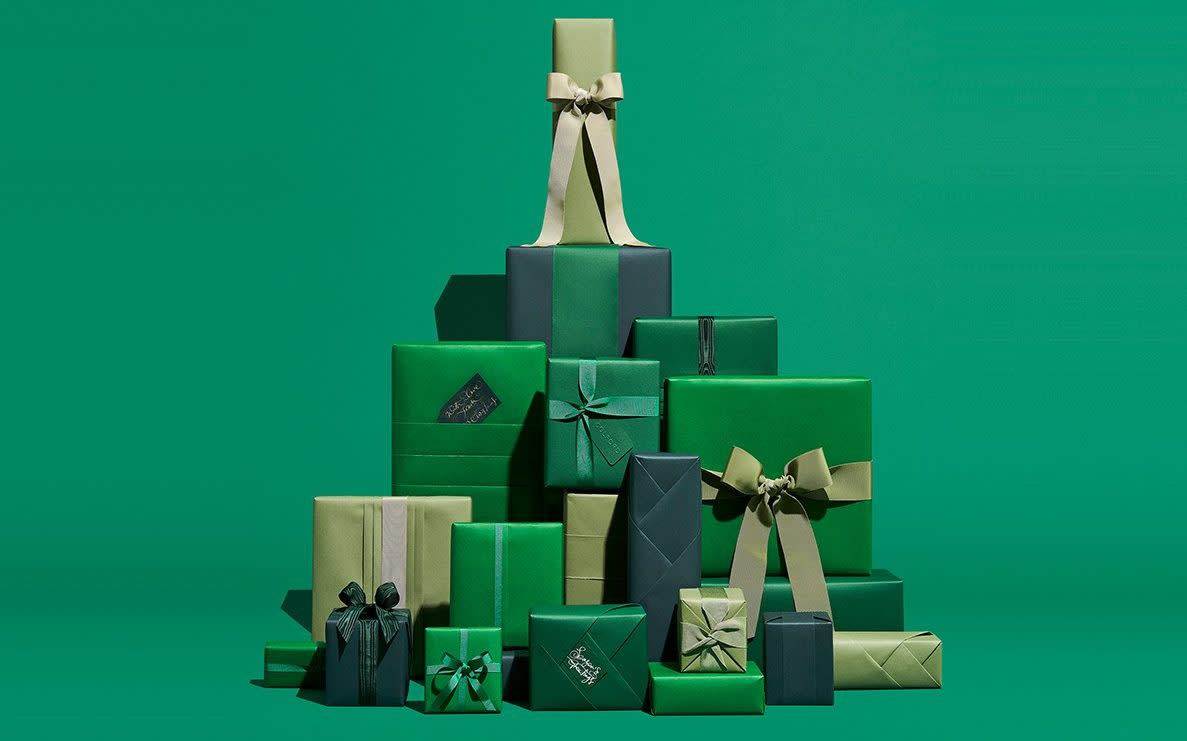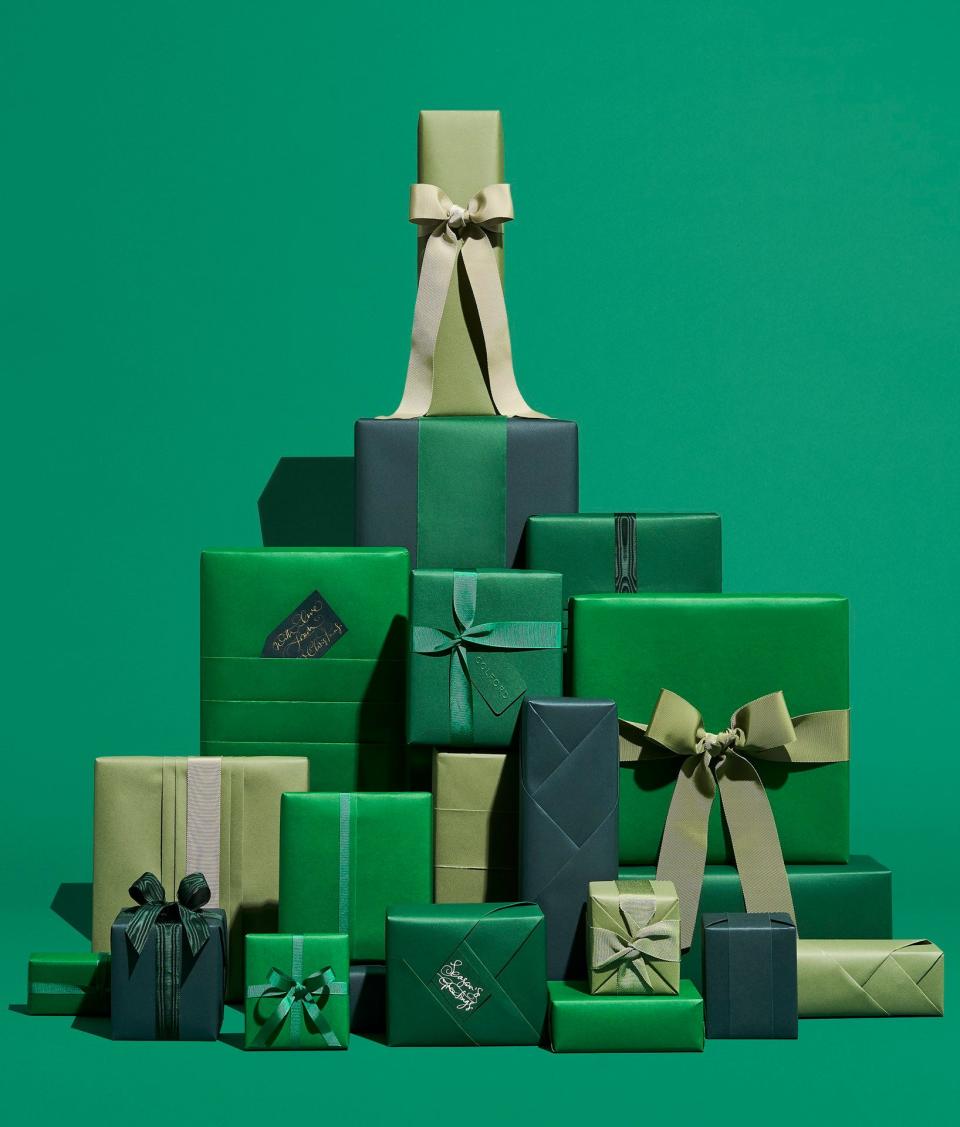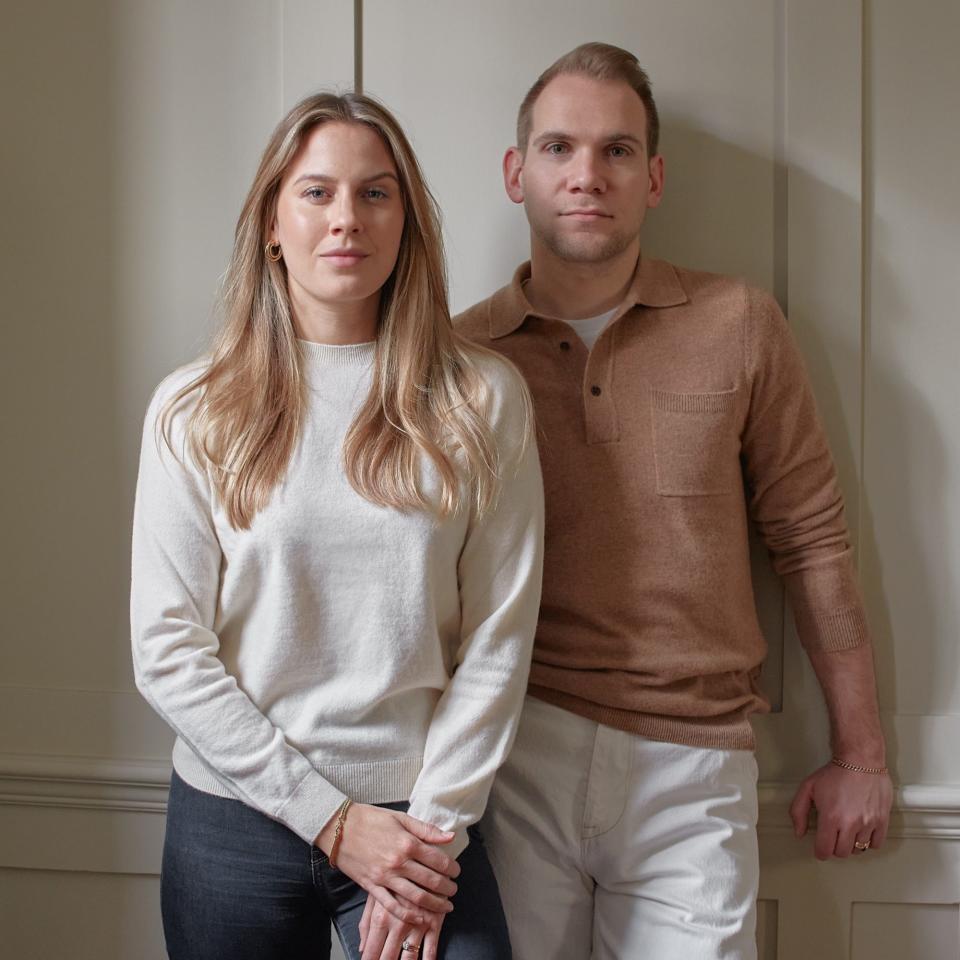Preparation, narratives and 1950s ribbon: How the experts wrap Christmas presents


‘There are two types of people in this world,’ says Imogen Beresford, co-founder of the luxury gift-wrapping service Colford. ‘Those who love to wrap, and take time on all the details. And those who shove it in a gift bag.’
It is the former camp that is out to impress this Christmas, encouraging us all to make what’s under the tree look more stylish and coordinated than in previous years. The goal is a thematic scene of gifts, showcasing an unexpected colour scheme, lavish ribbons or unusual tags, chiming merrily with your overall festive decorations.
The reality, of course, may be somewhat more scrappy. My own efforts over the years could generously be described as a ‘collage’ – essentially I use a mash-up of whatever mismatched papers I have in the bottom drawer. But when I visited a friend’s house recently and saw a living room filled with White Company decorations, and gifts decked in coordinated craft papers and white raffia bows, I realised it was time to sharpen up.
And now is the moment to grasp the scissors: this weekend we will reach the peak of wrapping season for the year. The average Briton has, by now, tackled most of their shopping, save for a few last-minute items. What comes next is the momentous task to tie it all up with a bow. We are a nation divided as to whether we love or hate this time-consuming task – 49 versus 51 per cent according to a survey conducted by Amazon last Christmas.
If you have ever doubted your own skills as a wrapper, Beresford and her business partner Nathan Cole will make you feel particularly sub-par. Their specialism is picture-perfect gifts: they can execute decorative folds, statement pleats and sweet tucks to hide a note inside, all in minutes of precise handicraft.
To watch them work is to observe a pair of origami masters. Their superior eco-friendly papers are satisfyingly thick – but not so much as to hinder the wrap. Their ribbons are responsibly sourced; recycled or vintage. There is never, ever an ugly hint of visible tape (they can go tape-free, or secure trickier shapes with a patch of eco double-sided).
In the final weeks leading up to Christmas they wrap at an astonishing rate – more than a thousand gifts between two of them. Yet their workshop is calm and bright. A Byredo candle is burning, to set the mood with a suitably rich wintery scent. The pair also look chicer than your average elves: they wear tasteful beige knitwear, and their hands are impeccably manicured with no straggly nails or papercuts.
This branding of a stress-free, luxurious experience is what their customers come to them for. Their time-poor cash-rich clients seek exquisitely wrapped gifts that will make their recipient say ‘wow’ – and all before they’ve even had a chance to open them.
‘These days beautiful wrapping can add value to a gift,’ says Cole. ‘The whole unboxing experience is so important now to customers and if you can add to the narrative with a little story about where the packaging comes from, or have the recipient stop to admire a specially selected bow, you ultimately get more airtime on that present.’

Obviously social media has amplified the importance placed on a Christmas present’s appearance. Influencers can be found dedicating entire reels on Instagram and TikTok to ‘unboxing’ fabulous gifts. The celebrities are at it, certainly – you can google pictures of Reese Witherspoon and her chic navy and gold gift-wrapping theme, or the Kardashians, who annually adopt ‘house’ colour schemes as an extension of personal branding, so that others in their family branches know who each gift has come from. Then there’s the original celebrity wrapper, Candy Spelling, with a trio of gift-preparation rooms in her LA mansion, and Mariah Carey who (perhaps understandably) has four Christmas trees in her home, complete with tonal gifts under each.
But recently I’ve also seen civilian friends – with no priors as gift-wrapping boffins – post their gleeful ‘all done’ photos on Facebook. To snap your glass of red wine in front of a roaring fire, with your pile of beautifully done-up gifts in the background, all ready to dish out, is quite the festive humble brag.
Beresford and Cole were two such friends. They would exchange photos on WhatsApp of presents they had seen or received, and discuss their ideas for their families for the Christmas ahead. Seeing that their interest was shared by others on social media was one of the things that inspired them to launch their business earlier this year (both had also worked with luxury gifting and floristry companies previously).
‘People are curating their lives more,’ says Cole. ‘It’s because they know it’s going to be seen further afield. Before social media, how you wrapped your presents was only seen by the people you gave them to. Whereas now it’s content. There’s a whole economy there that didn’t exist a few years ago.’
This Christmas marks 20 years since Rowan Atkinson famously asked ‘would you like it gift wrapped, sir?’ in Love Actually. Playing a Selfridges salesman, he boxes, cellophanes, tucks and ties Alan Rickman’s pendant necklace gift, before adding a scoop of potpourri, a four-inch cinnamon stick and a sprig of holly for the ‘final flourish’.
But the idea of gift wrapping a present in beautiful packaging to make it all the more attractive and intriguing, is an ancient Chinese tradition. The Victorians popularised wrapping in Western culture, as people began to decorate their own gift papers with marbling techniques. Then it was the American Hall brothers (of Hallmark fame) who in 1917 ultimately invented the modern patterned wrapping paper as we know it today.
Many of the ‘house fold’ techniques used by Colford derive from origami, while another popular trend being taken up again this year is furoshiki – the Japanese art of wrapping in reusable cloth packaging, which can be traced back to the 1600s. The Devonshire company Wrag Wrap specialises in this type of packaging, and offers a range of wrapping cloths in dozens of prints and colours, as well as a selection of vintage scarves which themselves become an extra gift for the recipient.
In 2021, it launched a rentable wrapping service. Simply select the number of wraps you need, pay for them (plus a refundable deposit) and return them in the post after Christmas. This works best, one would assume, on gifts that you don’t intend to send to relatives far and wide.
‘It’s the ultimate way of minimising consumption without being a total killjoy,’ says Nicky Rajska, a co-founder, who says that the number of people renting wrapping has doubled year-on-year. ‘The majority of customers send back their wraps in their prepaid box, and we do cleaning and repairs as necessary. Some keep them and give them as part of the gift. It’s resonating, this circular economy.’
As a nation we want to do better – aesthetically, yes, but also with eco-friendliness in mind. We’re all guilty of dumping sacks full of trashed wrapping paper on Boxing Day, and of accidentally muddling foil papers and shiny bows in the same bag. Most papers and gift bags on the market are still produced in non-sustainable circumstances: any kind of gloss, sheen, or metallic snowflake effect is usually made of virgin plastic. But just as the fashion industry has had to make a more conscious effort to be more sustainable, so too has the gift-wrapping world.
On the high street this Christmas, eco wrapping is now more of a priority. Marks & Spencer has reviewed its gift paper materials for 2023, as has Sainsbury’s Habitat range. ‘Sustainability is super important in this area,’ says Lisa Cherry, head of Christmas at John Lewis. ‘All of our wrap is glitter-free, fully recyclable and made from FSC-certified paper. We have moved our bows and ribbons into sustainable options too, so that they can be fully recycled. Raffia ribbon and paper bows have all proved popular with customers.’
Shopping for papers from B Corp-certified companies or looking out for the FSC stamp on a roll is one thing anyone can do, on any budget.
Colford’s mission is to embrace the most innovative of eco-friendly materials, without compromising on style.‘The techniques that are coming through are so interesting,’ says Cole. ‘We now work with wrapping papers made from seaweed fibres, from spent brewers grain, from flax – all sorts of things.’
The storytelling that comes with this is part of the fun. Wrapping a present in beer paper (colour options include Lager, Pils and Ale) and knowing that you can compost said paper afterwards, seems particularly clever. I expected, to touch, that the seaweed paper might feel crispy or dry, but instead it is completely smooth.
Ribbons can be problematic, as so many out there are made from new polyester. Colford uses a selection of grosgrain ties made from recycled plastic bottles, as well as vintage and deadstock ribbons. ‘It is really quite lovely to be able to tell a recipient that their present is tied with a ribbon from the 1950s,’ observes Cole.
It’s easier than you might think to source something exciting – the haberdashers Kleins of London, which launched in 1936 but sadly shuttered during the pandemic, is still trading deadstock and vintage trims online (kleinshaberdashery.co.uk).
For anyone keen to have a go at some professional techniques at home this year, the team at Colford have some top tips.
‘The key is in the preparation,’ says Beresford. ‘Getting the right paper size will save you so much trouble, otherwise you end up with not enough, or too much bulk and you’re trimming retrospectively and never get a straight line. And if it’s a rounded shape, printed papers also hide a lot of sins.’
‘If you have a complicated shape you could even do a dummy run and make a net first with newspaper,’ adds Cole.
If you really are terrible at wrapping, you can outsource the task. Prices for Colford’s bespoke services begin at £19 per gift. On TaskRabbit, as well as booking helpers who will clean your kitchen, or mow the lawn, you can also hire a wrapper. An average ‘tasker’ via that service will charge you £29.90 per hour. To the critic who says you’ve cheated by removing your own personal touch from the process? Rebrand the sentiment, and say it all adds to the story.
Many department stores and local boutiques can also gift wrap for you when you purchase the present, but typically it will be in their house style or colours. Some are seeking to make this option more customisable – Selfridges this year has a dedicated ribbon bar, with 60 colour choices akin to a mini haberdashery.
‘The thought and effort put into how a gift has been wrapped is all part of the “giving” ceremony itself, making the recipient feel extra special,’ says Eleanor Gregory, Selfridges’ homeware buying manager, who says the service is 45 per cent busier in the eight weeks before Christmas. They encourage customers, Gregory says, to be ‘a bit “extra” with their wrapping’.
With all the gift-wrapping trickery in the world, can you ever disguise a truly rubbish present? ‘What’s inside still counts,’ confirms Cole. ‘But you can certainly elevate the experience.’
I’m converted, and will this Christmas be going all in. My recipients should expect upcycled ribbons and smart brown paper, fancy folds and charming tags. Even if my two-year-old tears through the results like a small animal on the big day…


